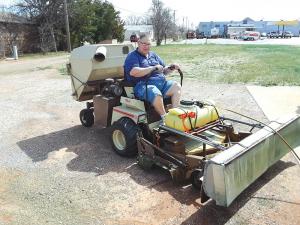2023 - Volume #47, Issue #4, Page #16
[ Sample Stories From This Issue | List of All Stories In This Issue | Print this story
| Read this issue]
Hooded Lawn Sprayer Turns On A Dime
 |
“The mower is a 932 Grasshopper,” says Penick. “It was the strongest they made when I bought it and has a 52-in. mower deck. I removed the wheels from a tow-behind sprayer and set it on the platform.”
He fabricated the platform with 1-in. sq. steel tubing. Legs on the front and back of the platform rest on the mower deck. Penick built a bracket to attach the platform to the heavy-duty cross pipe the mower deck is hinged to.
“The platform is handy for hauling things in addition to the sprayer tank,” says Penick. “I have seats I can attach for the grandkids to ride on.”
A rear-mount lawn vacuum eliminated that position as an option. However, Penick likes having the deck in front of him. It ensures ready access to the tank for refills. Having the spray tank in front of him also makes it easy to check spray solution levels.
A 12-volt plug-in on the Grasshopper made it easy to connect the spray pump. Penick mounted an on/off switch for the sprayer on the mower handlebar.
“It shuts off the spray solution, so nothing is wasted,” says Penick.
Spray can be delivered via a 10-ft. hose with a wand or the spray hood. A quick connect lets Penick detach the hose and direct the flow to the spray hood.
“I drew up plans for what I wanted,” says Penick. “The hood is about 20 in. high and about 60 in. wide. A friend at a metal shop put a 90-degree curve in the top rear. The front shield is hinged to the hood so it can fold back for access to the spray tips.”
Penick made support arms for the hood with two lengths of 1-in. conduit. He reinforced them by clamping lengths of rebar to them. Brackets made from steel strap are welded to a length of angle iron that is screwed to the back side of the hood. The brackets bolt and clamp to the ends of the arms.
“The arms bolt to the platform at either end of the spray tank,” says Penick. “To remove the hood, I just take out the bolts and disconnect the feeder hose from the spray tank.”
A 4-ft. spray bar made from a length of conduit is mounted inside the hood. It’s clamped to the ends of the conduit arms, which extend slightly through the back side of the hood. Four spray tips and the spray solution feeder hose are clamped to the conduit. Penick clamped short lengths of angle iron to the spray bar and drilled holes through them to hold the spray tips in place.
By mounting the sprayer and the hood to the mower deck, Penick can adjust the height of the spray tips. Short lengths of belting bolted to the bottom rear of the hood prevent any spray from escaping the hood.
“Even in a blowing wind, I don’t have to worry about spray coming back at the mower,” he says.
Contact: FARM SHOW Followup, Tyrone Penick, 13806 Village Circle, Edmond, Okla. 73013 (ph 405-496-2319; tpenick42@gmail.com).

Click here to download page story appeared in.

Click here to read entire issue
To read the rest of this story, download this issue below or click here to register with your account number.




